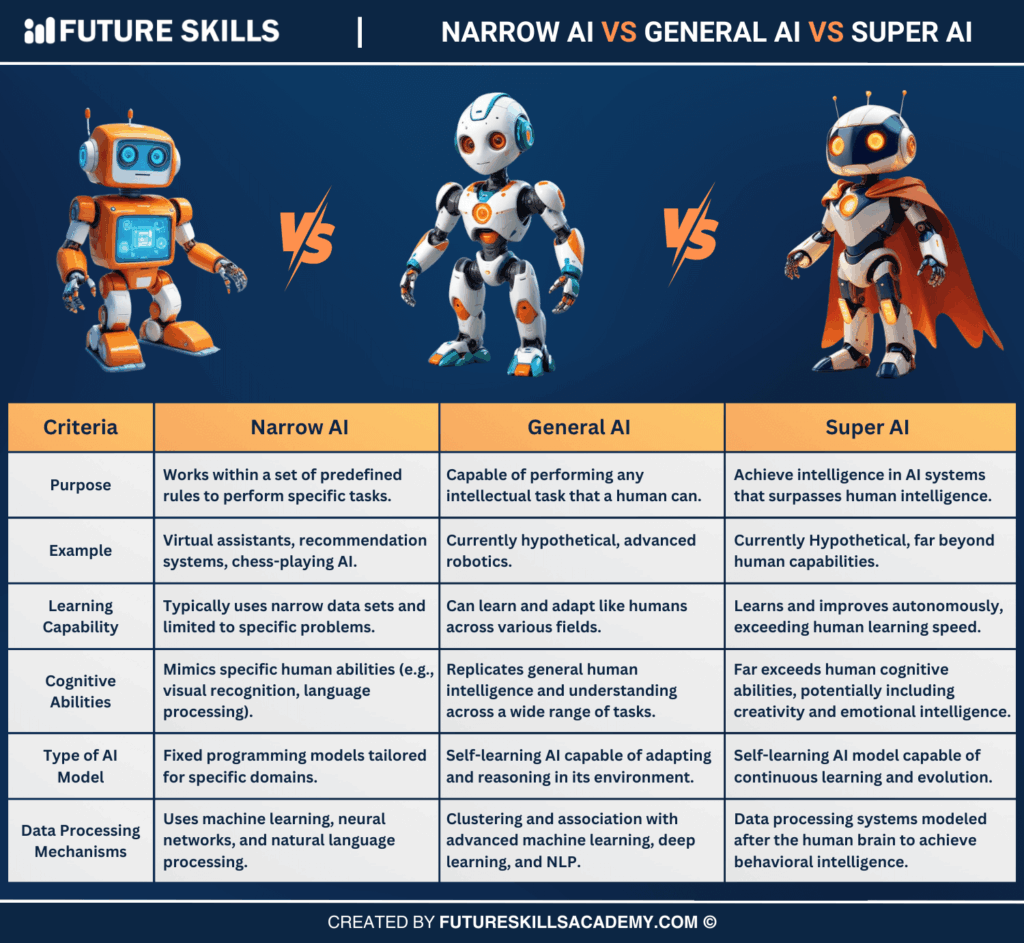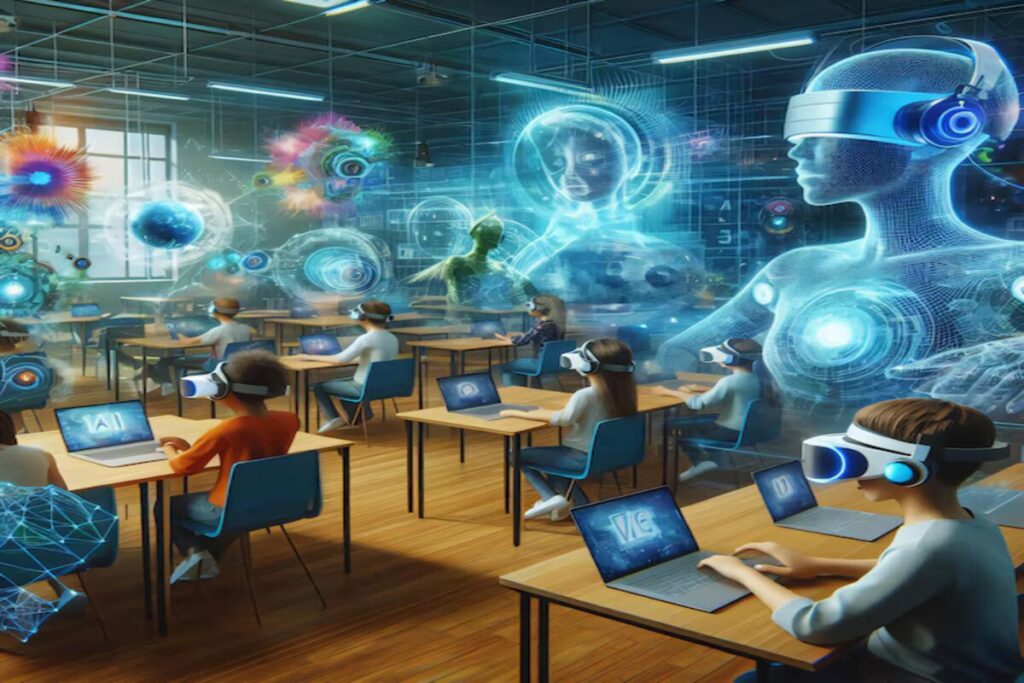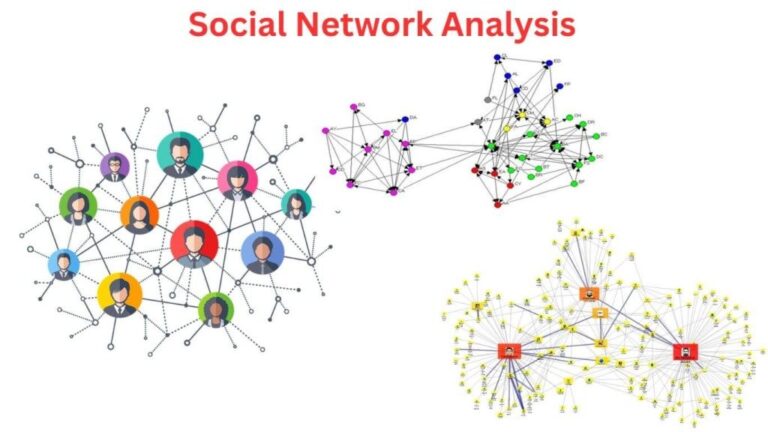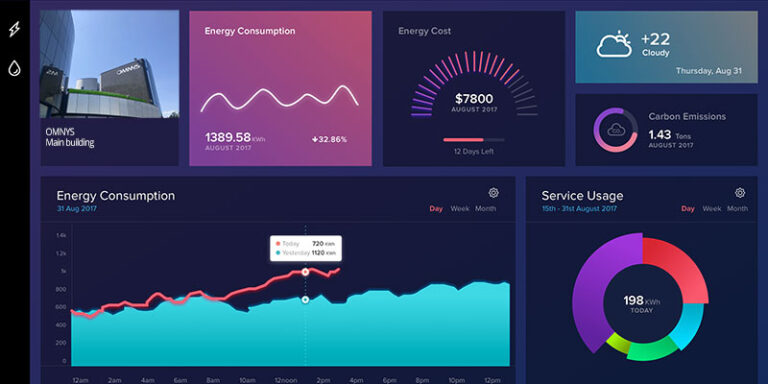What Is Artificial General Intelligence (AGI), Anyway?
Alright, let’s break the ice with something we can all agree on: the term Artificial General Intelligence sounds like something you’d find in a sci-fi movie where the toaster suddenly decides it’s smarter than you. But AGI is no longer just a plot device; it’s very real, and it’s unfolding right now.
AGI is a type of artificial intelligence that doesn’t just excel at one task (like playing chess or recommending cat videos), it learns, adapts, and performs any intellectual task a human canIt’s’s the Einstein of machines.
Narrow AI vs AGI: Know the Difference

Before we dive into real-world examples, let’s clear up a big misconception. Most of what you call AI today, think Siri, Alexa, or your robot vacuum that keeps eating your socks, is narrow AI. It’s good at a specific job, but that’s about it.
AGI, on the other hand, is your dream inter. It can learn new things, think abstractly, apply logic, and solve new problems without being spoon-fed the answer. Big difference.
1. AlphaZero by DeepMind: The Game Master
Let’s start with something that made headlines: AlphaZero. DeepMind built it to master games like chess, shogi, and Go, but with a twist. Unlike traditional game AIs, AlphaZero wasn’t preprogrammed with strategies. It learned everything on its own.
It started clueless. Then it played millions of games against itself and became unbeatable. No human help, just pure self-learning. That’s AGI behavior, my friend.
Estimated Training Cost Table
| Resource | Estimate |
|---|---|
| Compute Time | Several days |
| Cloud GPU Cost | $25,000–$50,000 |
| Human Supervision | Minimal |
2. GPT-4 by OpenAI: The Chatterbox That Thinks
If you’ve chatted with ChatGPT (hi, it’s me!),You’ve met GPT-4. This language model isn’t just a clever autocomplete; it understands context, generates ideas, and even cracks jokes.
While it still has some quirks (don’t ask it to do calculus while rhyming in Klingon), GPT-4 can write poetry, solve logic puzzles, tutor math, and simulate human-like reasoning. It’s not fully AGI yet, but it’s knocking on the door.
3. Gato by DeepMind: One Brain, Many Skills
Gato is DeepMind’s attempt at a generalist agent. One neural network, dozens of tasks. Gato can play video games, describe images, control a robot arm, and even chat all without needing a new brain each time.
This is a big AGI milestone: one model, many skills. Imagine if your coffee machine could also babysit your kids and help with taxes. Not saying that’s what Gato does, but we’re getting there.
4. Tesla’s Full Self-Driving AI: Road Intelligence
Tesla’s Full Self-Driving (FSD) system aims for more than just autonomous driving; it wants adaptive, human-like decision-making. That means responding to unexpected obstacles, road signs, aggressive drivers, and even weird weather.
We’re still in beta, but the system’s ability to process vision, predict human behavior, and make real-time decisions across varied environments is a peek into AGI-style reasoning.
5. Meta’s CICERO: Diplomacy AI with Emotional Intelligence

Meta (yes, Facebook’s parent) built CICERO to play the strategy game Diplomacy. Unlike chess or Go, Diplomacy is all about negotiation, deception, and alliances. CICERO blends natural language understanding, emotional nuance, and strategic thinking.
This isn’t just logic, it’s social intelligence. And it’s a huge step toward machines that can interact like humans and outsmart us in conversation.
6. Robotics + AGI: From Boston Dynamics to Google DeepMind
Robots are cool. But robots powered by AGI? That’s next-level. Take Boston Dynamics’ Spot robot. On its own, it’s agile and responsive. Now imagine Spot with AGI: it could plan tasks, adapt to new environments, and even work with human teams.
DeepMind’s work with robotics is moving in that direction. Learning not just motion, but purpose. That’s when robots stop being tools and start becoming colleagues.
7. IBM Watson (Post-Jeopardy): Medical AGI in the Making
Watson was famous for winning Jeopardy! Back in 2011. But its post-show career is even more interesting. IBM’s been using Watson to tackle healthcare from cancer diagnostics to personalized treatment plans.
While it’s not quite AGI, the vision is clear an adaptive, ever-learning system that supports doctors with reasoning, not just data lookup.
8. Personal AGI Assistants: Beyond Siri and Alexa
Imagine an AI that remembers your habits, understands your moods, plans your day, handles your inbox, books your flights, and maybe even breaks up with your cable company for you.
We’re not quite there yet, but personal AGI assistants are on the horizon. Think of them as life managers who never ghost you.
9. AGI in Scientific Discovery
AGI can already help discover new drugs, explore unknown physics, and even design proteins. DeepMind’s AlphaFold is a star example; it predicted the 3D structure of proteins faster and better than most biologists.
Now scale that thinking to chemistry, physics, climate science… You see where this is going? AGI isn’t just for cool gadgets; it’s a partner in discovery.
10. AGI in Education: Personalized Learning

Imagine a tutor that understands exactly how you learn, adapts its teaching style to you, never gets tired, and knows every subject under the sun.
Projects like Khanmigo (from Khan Academy, powered by OpenAI) are early examples. As AGI matures, this could completely transform how we learn from preschool to PhD.
Requirements Table for Personalized AGI Tutors
| Component | Requirement |
| Personalization Engine | Deep reinforcement learning |
| User Feedback Loop | Real-time response mapping |
| Data Privacy Tools | Secure storage and encryption |
What Makes These AGI Examples Important
Let’s pause and reflect. These aren’t just cool AI projects. Each one chips away at the old assumption that only humans can be flexible, thoughtful, and general-purpose thinkers.
They highlight a shift: from task-specific software to adaptable, curious systems. That’s the heart of AGI.
Challenges Facing Artificial General Intelligence Today

We’ve seen the promise, but AGI is not without its roadblocks. Here’s what keeps researchers up at night:
- Alignment with human values
- Bias and fairness in data
- Explainability (why did it make that decision?)
- Economic and job disruption
- Safety and control mechanisms
In other words, building AGI is hard. Making it safe is even harder.
AGI in Pop Culture vs Reality
Pop culture loves to paint AGI as either a savior (hello, Jarvis) or a menace (looking at you, Skynet). But real AGI? It’s way more subtle.
Instead of robots waging war, we have machine collaborators improving logistics, diagnostics, and education. Less Terminator, more TED Talk.
Conclusion: The Future of Artificial General Intelligence Examples
We’ve taken a whirlwind tour of some of the most fascinating, real-world artificial general intelligence examples. From language to logistics, healthcare to homework, AGI is starting to stretch its wings.
It’s not all-knowing yet, but it’s learning faster than ever. The examples above show what’s possible now, and hint at what’s coming next. The line between machine and mind? It’s getting blurry.
Artificial general intelligence isn’t science fiction. It’s the next phase of human-technology partnership — and it’s already begun.
FAQ: Artificial General Intelligence Examples
- What is the most advanced AGI example today?
GPT-4 and DeepMind’s Gato are strong contenders, each showing multi-task capabilities approaching general intelligence. - Is AGI the same as AI?
No. AI is usually narrow and task-specific. AGI can perform many tasks and learn like a human across domains. - Can AGI replace human jobs?
Potentially, yes, but it can also create new roles and free up time for more creative and strategic work. - Are there AGI robots?
Not fully. But robots powered by generalist AI (like some Boston Dynamics and Google projects) are getting closer. - Is AGI dangerous?
It can be if not properly aligned with human ethics and safety standards. That’s why so many researchers focus on safety and transparency.






